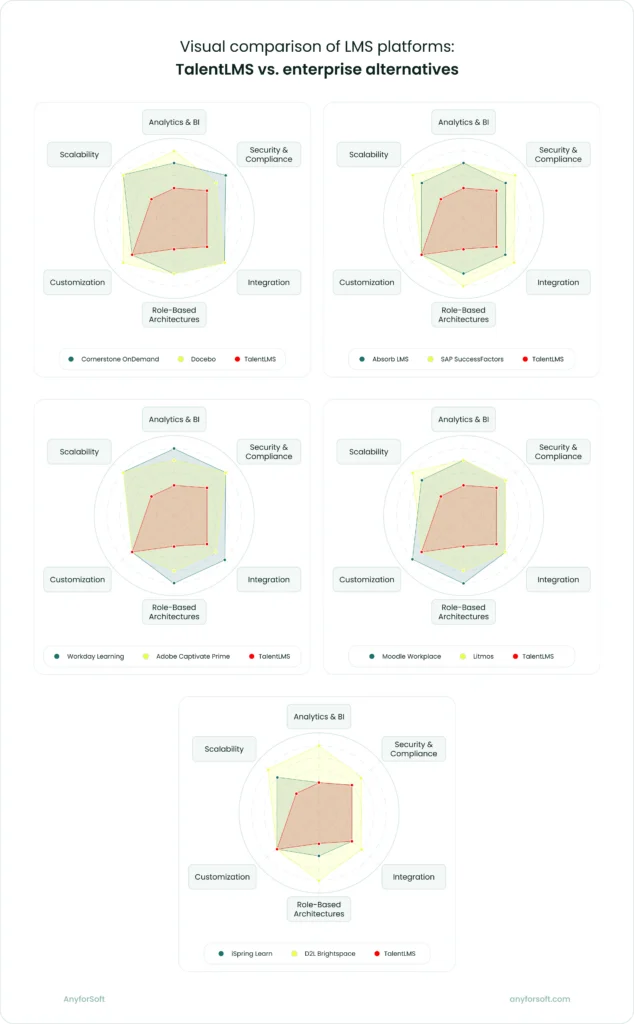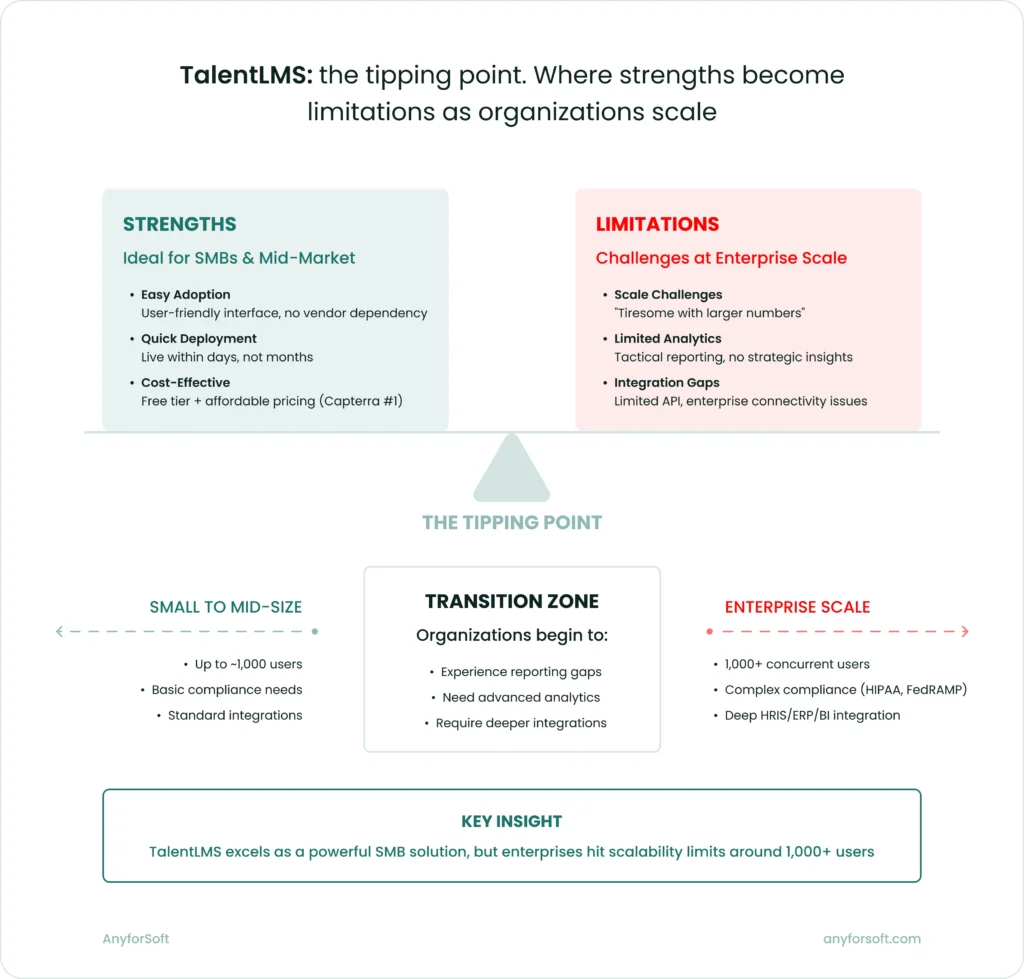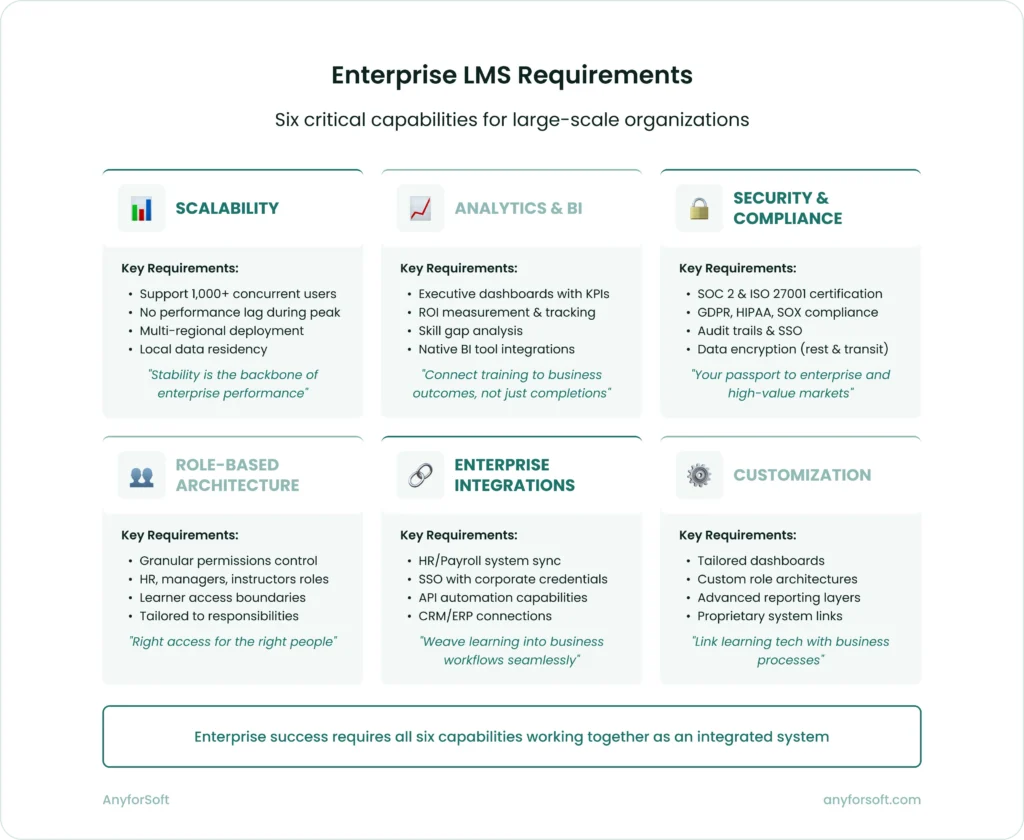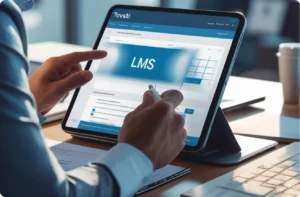TalentLMS is a well-known and powerful solution for onboarding new employees, compliance training, skills development, and product education for customers. However, an attempt to choose a better alternative signals awareness that the platform has limitations. This article clarifies a few details on the way to find the best fit among TalentLMS alternatives.
The overview is based on the following pillars:
- Comparative analysis of platforms — to identify leading enterprise-ready solutions
- Strengths of TalentLMS — to understand what makes an LMS effective
- Weaknesses of TalentLMS — to make sure that its capabilities are really insufficient for certain purposes
- Must-have features for modern LM — to establish evaluation criteria for companies
Whether organizations are outgrowing their current system or conducting initial LMS research, this guide provides the framework for selecting a learning platform that matches organizational needs.
Best alternatives to TalentLMS — Comparative Analysis
TalentLMS works well for small and mid-sized companies, offering a rare balance of simplicity and functionality. But as organizations scale, the same qualities that make it attractive can limit its role as a fully integrated enterprise platform.
To make those limitations more concrete, the table below provides a side-by-side reference. It brings together six core evaluation criteria (scalability, analytics, compliance, integrations, governance, and customization) so readers can quickly see how leading alternatives compare. Full details follow in the next sections, while sources are listed at the end of the page.
What are some good alternatives to TalentLMS? Capability comparison
| Platform | Scalability | Analytics & Business Intelligence | Security & Compliance | Enterprise Integration Capabilities | Role-Based Architectures | Customization |
| TalentLMS | SMB/mid-market; up to ~1,000 users on standard plans; multi-branch support | Basic reporting; Google/Zoho integrations; operational | GDPR, PCI DSS, AES-256, 2FA, AWS hosting | CRM, HR, Google Apps, SSO, Payments, Zapier | Admin, Instructor, Learner + customizable types; branch/group perms | Portal branding, themes, workflows, group/branch customization |
| Cornerstone OnDemand | Large enterprises; global scale; multi-division support | Advanced predictive analytics; BI integrations (Snowflake, PowerBI) | ISO 27001, SOC 1&2, FedRAMP, PCI, FDA Part 11 certifications | Extensive APIs & native connectors (HRIS, CRM, analytics) | Dynamic roles; automated group assignment; custom content/navigation by role | Deep customization: branded portals, dynamic interfaces, template workflows |
| Docebo | Enterprise/global; 100k+ users; multi-tenant, cloud auto-scaling | AI-powered dashboards; integration with Snowflake, BigQuery, QuickSight | ISO 27001/27017/27018/27701, SOC 2, PCI DSS, FedRAMP, GDPR, FDA 21 CFR Part 11 | Extensive API and connectors for HRIS, CRM, payroll, SSO, video | Full RBAC; dynamic role assignment; adaptive UI/menu customization | Deep customization: adaptive navigation, branded portals, no-code builders |
| Adobe Captivate Prime | Enterprise AWS cloud; clustered, infinite concurrency, CDN-backed | AI recommendations; Power BI integration; advanced dashboards | FedRAMP certified; MFA; tenant isolation; encryption | Adobe Experience Suite, Salesforce, SSO, FTP/CSV user import, APIs | 6 roles; granular permissions; group/user management | Theming, personalized dashboards, AI-driven learning paths, gamification |
| Moodle Workplace | Modular; multi-tenant; auto-scaling; 10k+ users | Built-in + IntelliBoard; predictive and customized dashboards | SOC 2 Type 2, GDPR, MFA, WCAG 2.1 AA; encryption; privacy by design | LDAP, SAML, OpenID SSO; API extensibility; integrates with HR/ERP/CRM | Granular RBAC by role/group/org unit; multi-tenancy support | Theming, personalized workspaces, plugins/add-ons, mobile-friendly UX |
| Litmos | Enterprise-grade; multi-tenant; mobile-first; millions users | Real-time dashboards, automated reporting, AI personalization | SOC 2 Type II, ISO 27001, GDPR, EU–U.S. Data Privacy Framework; 24/7 monitoring; MFA; global data residency | API-heavy; CRM/Marketing/SAP integrations; SSO; automated provisioning | Custom roles; team and group management; fine-grained permissions | Portal themes, gamification, personalized paths |
| iSpring Learn | Scales for tens of thousands of users; mobile/offline support; flexible pricing | Customizable and scheduled reports; no real-time analytics | ISO 27001/27701; daily security scans/pen tests; SSL/TLS encryption; lacks built-in 2FA yet | REST/SOAP API; SSO; integration with HR/ERP/BI systems, conferencing tools | Custom roles with fine permissions; admin/instructor/learner separation | Branding, app theming, authoring tool integration, offline mode |
| D2L Brightspace | Microservices architecture; 99.95% uptime; global multi-device support | Performance+ dashboards; predictive analytics; Power BI integration | ISO 27001/27017/27018/27701; GDPR; enterprise security programs | 1EdTech open standards; full APIs; SSO; MS Teams AI integration | Advanced RBAC with granular permissions and multi-group access | Adaptive content; personalized dashboards; branded UI; AI features |
| Absorb LMS | Enterprise/global scale, multi-tenant, mobile-friendly, millions of users | Embedded BI with dashboards, forecasting, automation, AI-based personalization | SOC 2 Type II, GDPR, PCI DSS, WCAG 2.0; multi-regional data residency | Open API, SSO, CRM, HRIS, video conferencing, and payroll integrations | Multiple admin/manager roles with customizable permissions and group management | Deep branding, gamification, personalized dashboards, mobile theming |
| SAP SuccessFactors Learning | Global enterprise, modular PODS architecture; millions of users | Workforce Analytics with interactive dashboards, HR integrated BI | SOC/ISO certified, GDPR, HIPAA, audit trail, risk management features | Deep SAP HCM integrations, LinkedIn Learning, Microsoft Teams, workflow automations | Advanced Role-Based Permissions with security domains, workflow-based access | Branded portals, segmented catalogs, customizable notifications, adaptive learning |
| Workday Learning | High-scale enterprise cloud, multi-region with elastic scaling; hundreds of thousands users | Prism Analytics, Illuminate AI, predictive analytics, workforce planning | SOC, ISO, GDPR, HIPAA compliance; multi-factor authentication; encryption | Deep integrations with Workday HCM, ERP, Microsoft Teams, LinkedIn Learning | Detailed RBP with security domains, configurable by business roles/groups | Flexible branding, personalized dashboards, dynamic courses, custom workflows |
To bring these differences into focus, the following sections take a closer look at each TalentLMS competitor and alternative.
1. Cornerstone OnDemand
Where TalentLMS shines as a fast, effective choice for small-to-medium businesses (SMBs), Cornerstone was built from the ground up for layered hierarchies, and highly regulated environments.
Why Cornerstone outpaces TalentLMS
Scalability
If programs must expand across regions, Cornerstone supports thousands of users in worldwide deployments and keeps performance steady at scale.
Analytics and business intelligence
Native links to Tableau, Snowflake, and Power BI generate predictive dashboards that tie learning directly to ROI and workforce readiness.
Security and compliance
SOC 1 & 2, FedRAMP, and FDA 21 CFR Part 11 sit alongside ISO 27001, so the platform meets expectations in tightly regulated sectors from finance to healthcare to government.
Enterprise integration capabilities
With 200+ pre-built connectors, Cornerstone plugs into HR systems, collaboration tools, and analytics suites, embedding learning within enterprise workflows through comprehensive LMS integration services.
Role-based architectures
Sophisticated role assignments and automated group logic ensure each stakeholder—from executives to compliance officers—sees only what matters.
Customization
Deep branding, workflow templates, and navigation controls let enterprises shape the platform around their processes rather than bending to system immanent limits.
Cornerstone’s biggest strength is the blend of scale, analytics, and compliance into a cohesive enterprise backbone. Its trade-off as a TalentLMS’ alternative is greater complexity and cost; still, for global organizations with rigorous demands, it remains a top choice.
2. Docebo
Docebo targets global enterprises needing near-limitless scale, strong analytics, and AI-driven personalization. While TalentLMS focuses on fast, accessible learning for smaller teams, Docebo positions itself as a cloud-native SaaS LMS for complex, distributed organizations.
Why Docebo outpaces TalentLMS
Scalability
Built on high-availability cloud infrastructure, Docebo supports 100,000+ users with auto-scaling and multi-region deployments, ensuring uptime and smooth growth.
Analytics and business intelligence
AI-powered dashboards, predictive analytics, and native integrations with Snowflake, Azure Synapse, BigQuery, and AWS QuickSight automate insights and share them across business units—so leaders look forward, not backward.
Security and compliance
ISO 27001, SOC 2, PCI DSS, FedRAMP, GDPR, and FDA 21 CFR Part 11 align the platform with highly regulated industries, reinforced by e-signatures, SSO, audit trails, and regular third-party audits.
Enterprise integration capabilities
Hundreds of connectors and open APIs link HRIS, CRM, SSO, content libraries, workflow tools, Salesforce, and data warehouses, allowing training data to flow into core systems.
Role-based architectures
Granular RBAC lets Superadmins set precise permissions, automate assignments, and restrict visibility down to fields or features—including secure access for partners and resellers.
Customization
Custom branding, adaptive navigation, role-based dashboards, and no-code page builders tailor the journey for every audience.
Docebo’s combination of near-unlimited scalability and AI-driven analytics distinguishes it for enterprises with complex structures and ambitious growth.
3. Absorb LMS
Absorb LMS blends enterprise scalability with strong analytics and user-focused customization. While TalentLMS emphasizes speed and simplicity for smaller teams, Absorb steps in when organizations need reliability across larger, more complex ecosystems.
Why Absorb outpaces TalentLMS
Scalability
Absorb supports rollouts across regions, departments, and external audiences; its cloud architecture sustains high availability as user counts climb.
Analytics and business intelligence
Absorb Analyze brings enterprise BI into the LMS — forecasting, automation, and customizable dashboards track impact without external tools.
Security and compliance
SOC 2 Type 2, GDPR, PCI DSS, and WCAG 2.0 pair with 21 CFR Part 11 e-signatures, plus 2FA, audits, and disaster recovery to protect data and continuity.
Enterprise integration capabilities
Open APIs and ready-made connectors tie into CRM, HRIS, payroll, performance systems, and SSO, keeping learning inside the broader tech stack.
Role-based architectures
Built-in admin/manager roles plus custom roles with fine-grained permissions support governance across multiple audiences.
Customization
Branded portals, region-specific templates, and personalized dashboards — extended by advanced UI options and mobile theming — deliver tailored experiences for employees, partners, and customers.
Absorb stands out by pairing embedded BI with a multi-audience scale, fitting enterprises that serve both internal and external stakeholders.
4. SAP SuccessFactors Learning
SAP SuccessFactors Learning sits inside SAP’s enterprise ecosystem, serving multinationals with complex HR and compliance needs. TalentLMS, by comparison, better fits smaller organizations prioritizing speed and simplicity over deep alignment.
Why SAP SuccessFactors outpaces TalentLMS
Scalability
With modular PODS architecture, SuccessFactors supports millions of users and remains consistent during global rollouts.
Analytics and business intelligence
Interactive dashboards and benchmarking give HR leaders a clear view of impact, with segmentation by role, location, or department.
Security and compliance
Compliance with GDPR, SOC, ISO, and more includes audit trails and regulatory reports to sustain adherence at scale.
Enterprise integration capabilities
Native links to SAP HCM, ERP, Microsoft Teams, and LinkedIn Learning route training data directly into mission-critical systems.
Role-based architectures
Advanced Role-Based Permissions and workflow-driven access deliver precise governance.
Customization
Branded portals, personalized dashboards, and segmented catalogues adapt to internal groups or external audiences.
SuccessFactors’ key advantage as a TalentLMS alternative is its seamless connection to SAP’s HR ecosystem, turning learning into a fully integrated part of workforce management.
5. Workday Learning
Workday Learning serves large enterprises where training is tightly connected to HR and financial data. TalentLMS, in contrast, is best for smaller organizations needing a lightweight system without deep ties to other functions.
Why Workday Learning outpaces TalentLMS
Scalability
Workday supports hundreds of thousands of users, delivering global availability and multi-language environments for massive operations.
Analytics and business intelligence
Prism Analytics and AI provide real-time insight into learning and skills so leaders can forecast workforce needs and act strategically.
Security and compliance
SOC, ISO, GDPR, and HIPAA combine with encryption, audit trails, and MFA to meet stringent requirements.
Enterprise integration capabilities
Deep integration with Workday HCM and Finance — plus Microsoft Teams and LinkedIn Learning — keeps training connected to daily processes; APIs extend automation.
Role-based architectures
Configurable permissions align access with roles and workflows so managers, instructors, and admins see the right data.
Customization
Branding, configurable dashboards, and adaptive catalogues personalize experiences for departments and external audiences.
Workday Learning’s strength is its tight fit with the broader Workday ecosystem, uniting HR, finance, and learning.
6. Adobe Captivate Prime
Adobe Captivate Prime blends scale, compliance, and integration with Adobe’s ecosystem. TalentLMS remains a leaner tool for small and mid-sized teams.
Why Adobe Captivate Prime outpaces TalentLMS
Scalability
Clustered AWS hosting with auto-scaling and failover supports virtually unlimited global users; CDN and streaming keep delivery fast.
Analytics and business intelligence
AI recommendations and advanced dashboards deepen insight, with automated reports that unify in tools like Power BI.
Security and compliance
FedRAMP certification and encrypted storage suit federal and regulated contexts; SAML, MFA, and tenant isolation add extra protection.
Enterprise integration capabilities
Out-of-the-box connectors link Salesforce, Adobe Experience Manager, Marketo, and more; APIs and batch user management streamline workflows.
Role-based architectures
Six roles with granular access control secure internal and external audiences while simplifying administration.
Customization
Branded portals, personalized dashboards, and AI-driven paths, plus gamification and localized branding, elevate engagement.
Captivate Prime’s strongest pull is its tight integration with Adobe’s stack, combining marketing, analytics, and learning. This makes it a distinctive TalentLMS alternative.
7. Moodle Workplace
Moodle Workplace brings open-source flexibility to the enterprise, delivering scalability, compliance, and deep customization. TalentLMS suits quick wins for small teams; Moodle Workplace serves organizations seeking long-term control.
Why Moodle Workplace outpaces TalentLMS
Scalability
From small teams to tens of thousands, load balancing and auto-scaling, supported by certified partners, keep performance steady at peaks.
Analytics and business intelligence
Built-in analytics plus IntelliBoard power detailed course, user, and site-level reporting, with stakeholder-specific dashboards and scheduled delivery.
Security & Compliance
SOC 2 Type 2 and GDPR certifications, MFA, strong access controls, and annual accessibility audits support regulated use cases.
Enterprise integration capabilities
LDAP, SAML, OpenID, and open APIs integrate with HR/ERP/CRM systems; plugins extend automation across complex stacks.
Role-based architectures
Granular permissions by org unit, group, or role enable governance in multi-tenant setups and maintain clear audit trails.
Customization
Branded portals, adaptive paths, compliance management, and mobile UX, enriched by plugins and add-ons, let teams shape the platform precisely.
Moodle Workplace stands out for near-unlimited customization and extensibility, fitting processes exactly with professional Moodle development services.
8. Litmos
Litmos is a flexible cloud LMS that scales from midsize to global enterprises with millions of users. TalentLMS focuses on simplicity for smaller organizations.
Why Litmos outpaces TalentLMS
Scalability
Growth from hundreds to millions requires no major rework; multi-tenant design and mobile-first delivery speed global rollouts and compliance training.
Analytics and business intelligence
Real-time dashboards and automated reporting track progress, while AI personalization suggests tailored paths; some enterprises add BI tools for deeper analysis.
Security and compliance
SOC 2 Type II, ISO 27001, GDPR, and EU–U.S. Data Privacy Framework, plus continuous monitoring, MFA, and third-party audits, safeguard data across regions.
Enterprise integration capabilities
Open APIs, SSO, and integrations with CRM, marketing tools, and SAP streamline provisioning and sync.
Role-based architectures
Administrator, manager, and learner by-default roles, enhanced by custom ones, provide fine-grained control.
Customization
Branded portals, custom paths, gamification, and personalized dashboards, supported by a broad content library, boost engagement.
Litmos pairs scale with rapid deployment, appealing to teams that need to grow training quickly and securely.
9. iSpring Learn
iSpring Learn offers straightforward design and strong authoring, practical for growing organizations. TalentLMS serves small teams well; iSpring adds a path to scale with built-in content creation.
Why iSpring Learn outpaces TalentLMS
Scalability
Tens of thousands of active users are supported, with flexible pricing plus mobile and offline learning; on-premise options enable full control.
Analytics and business intelligence
Detailed reports on progress, quizzes, and events can be customized and scheduled, though real-time analytics and benchmarking are lighter than top enterprise tools.
Security and compliance
ISO 27001 and 27701 certifications, encryption, and daily security checks protect data.
Enterprise integration capabilities
REST/SOAP APIs, SSO, and connectors for HR, ERP, CRM, and BI centralize management; Teams and Zoom streamline delivery.
Role-based architectures
Custom roles and permissions let admins fine-tune access for instructors, learners, and managers.
Customization
Branded portals, mobile app theming, and iSpring Suite integration support rich content; UI changes are lighter, but adaptive paths and offline access add flexibility.
iSpring Learn’s signature, as one of the best TalentLMS alternatives, is its tight link to iSpring Suite, smoothing creation and delivery.
10. D2L Brightspace
D2L Brightspace is known for reliability and depth, which imply scalability, advanced analytics, and strong accessibility. TalentLMS fits SMBs; Brightspace serves institutions and enterprises with complex, global needs.
Why D2L Brightspace outpaces TalentLMS
Scalability
A microservices architecture supports thousands to millions, with 99.95% uptime and multi-device reach for peak-time stability.
Analytics and business intelligence
Performance+ adds predictive analytics, engagement dashboards, and assessment quality insights; Power BI integration extends analysis.
Security and compliance
ISO 27001 certifications and GDPR compliance, plus privacy commitments, deliver enterprise-grade protection.
Enterprise integration capabilities
Open APIs and 1EdTech standards enable interoperability with a wide range of edtech and enterprise tools; Microsoft Teams integrations extend collaboration.
Role-based architectures
Advanced RBAC with customizable permissions secures governance across departments, partners, and external audiences.
Customization
Personalised learning paths, adaptive content, branded interfaces, and dynamic dashboards, enhanced by AI-based tools, create flexible experiences.
Brightspace distinguishes itself with predictive analytics plus accessibility, offering insight and inclusivity at scale.
Expert Scoring Framework: LMS Platforms Evaluated
To provide a structured view of TalentLMS competitors, the AnyforSoft team developed a scoring model built on six enterprise-focused criteria.
Each platform was evaluated by a panel of experts, including:
- three software developers
- two project managers
- the CTO.
Scores (1–5) reflect consensus across all six criteria of evaluation.
The scoring is weighted to reflect enterprise priorities. Scalability, Analytics & Business Intelligence, and Security & Compliance were treated as higher-impact factors. The rest of criteria carried standard weight.
Why weighting? It ensures the results highlight platforms best suited for enterprise-scale deployments.
What are some good alternatives to TalentLMS? Comparative scores
| Platform | Scalability | Analytics & BI | Security & Compliance | Integration | Role-Based Architectures | Customization | Total Score |
| Cornerstone OnDemand | 5 | 4 | 5 | 5 | 4 | 4 | 27/30 |
| Docebo | 5 | 5 | 4 | 5 | 4 | 5 | 28/30 |
| Absorb LMS | 4 | 4 | 4 | 4 | 4 | 4 | 24/30 |
| SAP SuccessFactors | 5 | 4 | 5 | 5 | 5 | 4 | 28/30 |
| Workday Learning | 5 | 5 | 5 | 5 | 5 | 4 | 29/30 |
| Adobe Captivate Prime | 5 | 4 | 5 | 4 | 4 | 4 | 26/30 |
| Moodle Workplace | 4 | 4 | 4 | 4 | 5 | 5 | 26/30 |
| Litmos | 5 | 4 | 4 | 4 | 4 | 4 | 25/30 |
| iSpring Learn | 4 | 3 | 3 | 3 | 3 | 4 | 20/30 |
| D2L Brightspace | 5 | 5 | 4 | 4 | 5 | 4 | 27/30 |
| TalentLMS (reference) | 2 | 2 | 3 | 3 | 2 | 5 | 17/30 |

Expert scoring takeaway
The weighted evaluation across six enterprise-grade criteria highlights clear differences between platforms.
- Cornerstone, Docebo, and Workday lead in scalability and compliance, making them strong choices for global rollouts.
- Absorb and Litmos strike a balance between analytics, customization, and multi-audience support.
- Moodle Workplace stands out for flexibility and extensibility, while iSpring Learn offers a practical step-up for growing organizations.
The radar charts make these contrasts visible at a glance, showing where each platform excels and where trade-offs appear.
Together with the weighted scores, they provide a structured decision-making tool to guide enterprises in selecting an LMS aligned with their scale, compliance needs, and integration priorities.
The comparative analysis shows where enterprise platforms surpass TalentLMS, but a grounded decision also requires a closer look at TalentLMS itself.
By weighing both the advantages that drive its adoption and the limitations that surface at scale, organizations gain a clearer basis for choosing the right learning platform.
Why TalentLMS Dominates the E-learning Market
According to Gartner, the platform supports more than 70,000 teams in 124 countries across 30+ industries, positioning it as a visible player in the global learning technology market.
The solid ground for this popularity lies in several core competitive advantages.
Easy adoption across stakeholder levels
TalentLMS addresses the distinct priorities of each stakeholder:
- Executives value the ability to approve implementation without drawn-out procurement cycles.
- Finance leaders appreciate a pricing model that can be explained in minutes rather than hours.
- Project managers and administrators benefit from configuring courses or managing permissions without waiting on vendor assistance.
The user experience plays an equally strong role. As one lecturer noted in a Capterra review, the system’s dashboard is “best known for being user-friendly” and combines many straightforward tools so that even those with no prior LMS experience can navigate it comfortably.
Balance of power and simplicity
One reason TalentLMS has gained sustained traction is its ability to combine ease of use with enough depth to keep organizations engaged long after launch. The following capabilities make a platform distinctive:
- Balance between advanced functionality and simplicity. User reviews note that administrators can master the system quickly while still building efficient workflows. As one administrator wrote, “I was able to quickly learn the software’s limits and work within them to create an effective training curriculum.”
- Quick deployment compared to enterprise-heavy solutions. Organizations regularly report going live within days rather than months. One TalentLMS user shared, “Within a week, we had TalentLMS up and running and developed about 10 courses.”
- AI-powered content creation. Introduced in late 2023, TalentCraft placed TalentLMS ahead of many rivals in the AI adoption curve. Independent testing suggests that AI-based tools can cut content development time by 50% or more, giving training teams the ability to launch programs faster and respond more dynamically to evolving needs.
Cost-effectiveness
Cost efficiency is one of the strongest selling points of TalentLMS, and it applies to organizations of all sizes. The reasoning behind the platform’s cost-efficiency are as follows:
- Flexible entry point. TalentLMS includes a no-cost option that covers five users and one instructor, with unlimited courses, unlimited storage, and SCORM support. Unlike conventional free trials, this plan doesn’t expire and requires no credit card, letting teams test the platform’s capabilities without commitment.
- Affordability paired with strong functionality. Many reviewers note that even the lower-priced tiers deliver a wide set of features, making the platform cost-effective for small and medium-sized enterprises.
- Recognition for affordability in the LMS market. Capterra has named TalentLMS the most affordable LMS for two years in a row, citing its strong feature set, adaptable pricing, quick rollout, and low operating costs.
This combination of risk-free onboarding, predictable subscription options, and external validation has made TalentLMS a reliable choice for cost-conscious buyers.
These strengths explain why TalentLMS has become a trusted option for SMBs that prioritize speed and ease of use. Yet as organizations expand, features that once felt sufficient begin to show limits, especially in scalability and enterprise functionality.
Enterprise Reality Check — When TalentLMS Hits Its Limits
When it comes to TalentLMS, enterprises may encounter barriers once scale and complexity increase. Reviews from larger organizations reveal recurring issues that make growth harder to manage and signal when it may be time to evaluate alternatives.
Scale challenges
User feedback repeatedly notes that TalentLMS works best for small to mid-sized organizations but becomes “tiresome with larger numbers.”
Administrative tasks also become heavier at enterprise scale. Reviewers have pointed to difficulties with SSO integration and the time required to upload large batches of users. While manageable in smaller deployments, these friction points accumulate quickly when thousands of learners need to be onboarded.
Customization constraints
Another pain point enterprises often raise is the limited flexibility for branding and design. While the platform allows some adjustments, organizations looking to align portals or homepages with their corporate identity often find the options too narrow.
Reporting and analytics gaps
TalentLMS handles the basics of reporting, but reviewers often highlight significant gaps once leadership demands more advanced insights:
- Difficulty producing executive-level reports. One user noted that preparing monthly reports with metrics such as new logins, enrollments, and completions required manual effort rather than automated dashboards.
- Limited strategic analytics. While the system captures completions and usage data, it falls short on higher-value insights. Enterprises looking for benchmarks tied to organizational goals, skills readiness, or department-level ROI often need to rely on external tools.
- Validation through user migration. Companies that switched to other platforms often cite analytics as the deciding factor. As one user explained, they moved on because the system lacked a dedicated analytics module at the time, which was essential for executive reporting.
These constraints create a recurring challenge: reporting remains tactical rather than strategic.
Integration limitations
Enterprises often rely on a wide network of interconnected systems, from HR platforms to business intelligence tools. TalentLMS can integrate with common applications, but its scope remains limited once organizations demand enterprise-level connectivity.
API capabilities are functional but not robust enough for large-scale workflow automation. For companies that need to synchronize learning data seamlessly with HR systems, CRMs, or analytics platforms, this may create bottlenecks.
Cost escalation issues
While TalentLMS is widely recognized for its affordability at the entry level, cost concerns emerge once organizations begin scaling or adding enterprise features.
As one administrator explained,
“I manage four different LMSs as an admin. This used to be my go-to recommendation for small businesses because of the quick learning curve. After the recent price increase, which more than doubled the cost of the same plan without introducing new features, I can no longer consider it a good value.”
A major cost driver is the reliance on paid add-ons such as TalentLibrary, a catalog of ready-made courses. While useful, it can add $100–$250 per month for small teams and scale into thousands annually for larger organizations.

Enterprise LMS Requirements Deep-Dive
The challenges enterprises face with TalentLMS show that ease of use alone does not meet enterprise demands. Large organizations need systems that handle scale, deliver business insights, and integrate across operations. The key requirements below offer a framework for evaluating alternatives.
Scalability demands
If thousands of employees log in at once, the LMS must stay responsive. A system that supports 1,000+ concurrent users without lag is the baseline, because delays in onboarding or compliance erode trust quickly. At this level, stability is the backbone of performance.
Scale also means reach. Multi-regional deployment with local data residency ensures fast access everywhere while keeping data compliant with local rules. Without it, global programs feel like moving through mud—possible, but slow and exhausting.
Analytics and business intelligence integration
If reporting ends with completion rates, leaders lack the bigger picture. Executives need dashboards that connect training to KPIs and ROI, because only then does learning become a visible driver of business outcomes. Without that connection, training remains an isolated cost center.
Modern analytics go deeper than attendance logs. Engagement metrics show how learners interact with content, and skill gap analysis highlights where teams fall short. By using this data, enterprises build targeted programs instead of wasting resources on one-size-fits-all training.
Still, insights lose value if they sit in silos. Native integrations with BI tools like Tableau and Power BI keep learning data inside the decision-making flow executives already rely on.
Basic vs. enterprise analytics capabilities
| Reporting Area | Typical LMS (Baseline) | Enterprise LMS (Advanced) |
| Executive Dashboards | Course completions, logins | KPI tracking, ROI measurement, predictive insights |
| Engagement & Skill Gaps | Attendance, completion rates | Learner engagement scores, skill readiness, gap analysis |
| BI Integration | Manual exports (CSV, Excel) | Native connections to Tableau, Power BI, custom BI tools |
Security and compliance
Security is more than a formality; it is the passport into enterprise markets. A review by Schellman & Company found that organizations certified under both SOC 2 and ISO 27001 gained a competitive edge, proving to clients that the system had been validated by outside experts.
Compliance frameworks do more than tick boxes—they create trust, enforce rules, and provide the control executives expect.
When a platform aligns with GDPR, HIPAA, or SOX, enterprises can rely on it to adapt to strict sector regulations. Audit trails and SSO strengthen oversight, while encryption keeps data safe both at rest and in transit.
Security measures, on the surface, may look like an overhead cost, but in practice, they are what open the door to high-value markets.
Role-based architectures
As organizations expand, so do the types of users who touch the system. Role-based permissions allow HR, managers, instructors, and learners to work within boundaries tailored to their responsibilities. When access is aligned with real responsibilities, administrators avoid clutter, and executives can focus on oversight without wading through irrelevant detail.
Enterprise integration capabilities
There is no faster way to create inefficiency than to let the LMS operate in a silo. Strong platforms, by contrast, weave learning directly into business workflows (for detailed guidance on this process, see the ultimate guide to LMS integration):
- HR connectivity keeps user records in sync, so onboarding and offboarding happen automatically.
- Single sign-on (SSO) lets employees log in with their corporate credentials, reducing password fatigue while raising security.
- APIs for automation open the door to custom workflows, whether linking course completions to payroll bonuses or feeding compliance data into executive dashboards.
Embedding training into these operational flows ensures it feels like part of everyday work rather than an isolated system.
Examples of enterprise integrations
| Category | Example tools | Purpose / Value |
| HR & Payroll | Workday, BambooHR | Automatic user provisioning, record sync |
| Identity & SSO | Okta, Azure AD | Single sign-on, stronger security |
| Collaboration | Microsoft Teams, Slack | Push notifications, training reminders |
| Productivity | Google Workspace, Microsoft 365 | Calendar invites, file sharing |
| Analytics & BI | Tableau, Power BI | Advanced dashboards, ROI measurement |
| CRM/ERP | Salesforce, SAP | Linking training to sales or compliance |
When integration is strong, the LMS doesn’t sit on the sidelines. It plays as part of the team.
Customization
Even the strongest LMS platforms cannot cover every organizational requirement out of the box. Most enterprises eventually need capabilities that go beyond standard branding options or prebuilt workflows. They may require tailored dashboards, granular role architectures, advanced reporting layers, or direct links to proprietary systems that no vendor includes by default.
Some platforms offer deeper flexibility than others, but all reach limits once needs become highly specific. At enterprise scale, customization becomes a central requirement that links learning technology with business processes and keeps the LMS functioning as part of one ecosystem.

Conclusion: A Mini-Framework for Choosing the Right LMS
Selecting an LMS is less about choosing a “well-known” tool or the best TalentLMS alternatives. It’s more about aligning features with organizational strategy. The platforms compared in this guide show how needs shift as companies grow, from fast deployment and simplicity to scalability, compliance, and deeper integrations.
A structured approach helps narrow the options when you choose an LMS:
- Define scalability needs. Estimate how many concurrent users the platform must support today and in the future. Systems like Cornerstone or Docebo are designed for global rollouts with tens of thousands of learners.
- Clarify analytics expectations. Decide whether basic reporting is sufficient or if leadership requires predictive dashboards and ROI insights, as provided by Absorb or Workday Learning.
- Check compliance requirements. Map your regulatory environment. Organizations operating under frameworks such as HIPAA or FedRAMP often look to SAP SuccessFactors or Adobe Captivate Prime.
- Review integration priorities. List the systems the LMS must connect to—HRIS, ERP, CRM, BI tools. Platforms such as Workday Learning or SAP SuccessFactors provide deep native integrations that enterprises rely on.
- Assess governance needs. Determine how granular role-based permissions must be. If departments or regions require tailored oversight, solutions like Docebo, Moodle Workplace, or Litmos provide advanced architectures.
- Identify unique requirements. Many enterprises demand tailored dashboards, detailed role models, advanced reporting layers, or direct links to proprietary systems. In such cases, customization defines whether the platform becomes a seamless part of the ecosystem.
Taken together, these steps transform LMS selection into a methodical decision process—one that reduces risk and ensures the platform chosen can grow alongside the organization.
FAQs
The enterprise LMS market offers no shortage of strong contenders. Cornerstone OnDemand and SAP SuccessFactors are trusted where compliance and scale leave no room for error. Docebo earns praise for its AI-driven analytics and adaptability. Meanwhile, Absorb, Litmos, Moodle Workplace, Workday Learning, Adobe Captivate Prime, iSpring Learn, and D2L Brightspace each bring their own edge, whether that’s deeper integrations, flexible governance, or global reliability. The “best” option depends less on brand name and more on the priorities that drive your business forward.
The consequences show up faster than most expect. Adoption slows, teams grow frustrated, and reporting starts to feel like guesswork. Costs creep upward too, as extra tools are added to plug the gaps. Here is the lesson: miss critical factors (scale, analytics, or compliance) at the evaluation stage, and the platform will fail when demands rise. Switching later is always possible, but the cost is higher and the disruption steeper. Careful groundwork at the start is worth far more than patchwork fixes later.
Yes. Migration isn’t unusual; it’s a path many enterprises take once their old platform can’t keep up. Bulk user imports, SCORM or xAPI transfers, and SSO provisioning are common features offered by major vendors. Still, the process succeeds only with planning. Organizations that start small, test workflows with a pilot group, and then expand in stages avoid the chaos of a “big bang” switch. Done right, migration feels less like disruption and more like a natural next step.
Timelines vary widely. A lean system can be running in a week, while enterprise suites, like Cornerstone, Workday, or SAP SuccessFactors, may need several months of setup. Why the gap? Integrations, permissions, and compliance layers take time to align. The trade-off is predictable: quick setups give speed, complex builds give staying power. And once the heavy lifting is done, enterprises usually find the system runs more smoothly than the one it replaced.
Sticker prices are deceptive. True TCO stretches across subscriptions, integrations, implementation, support, and long-term scalability—usually measured over three to five years. A system that looks inexpensive at the start can become costly as needs expand, while a platform with higher upfront costs may actually reduce hidden spending later. Organizations that model these scenarios early on, instead of comparing licenses alone, avoid the trap of chasing short-term savings that erode in the long run.








